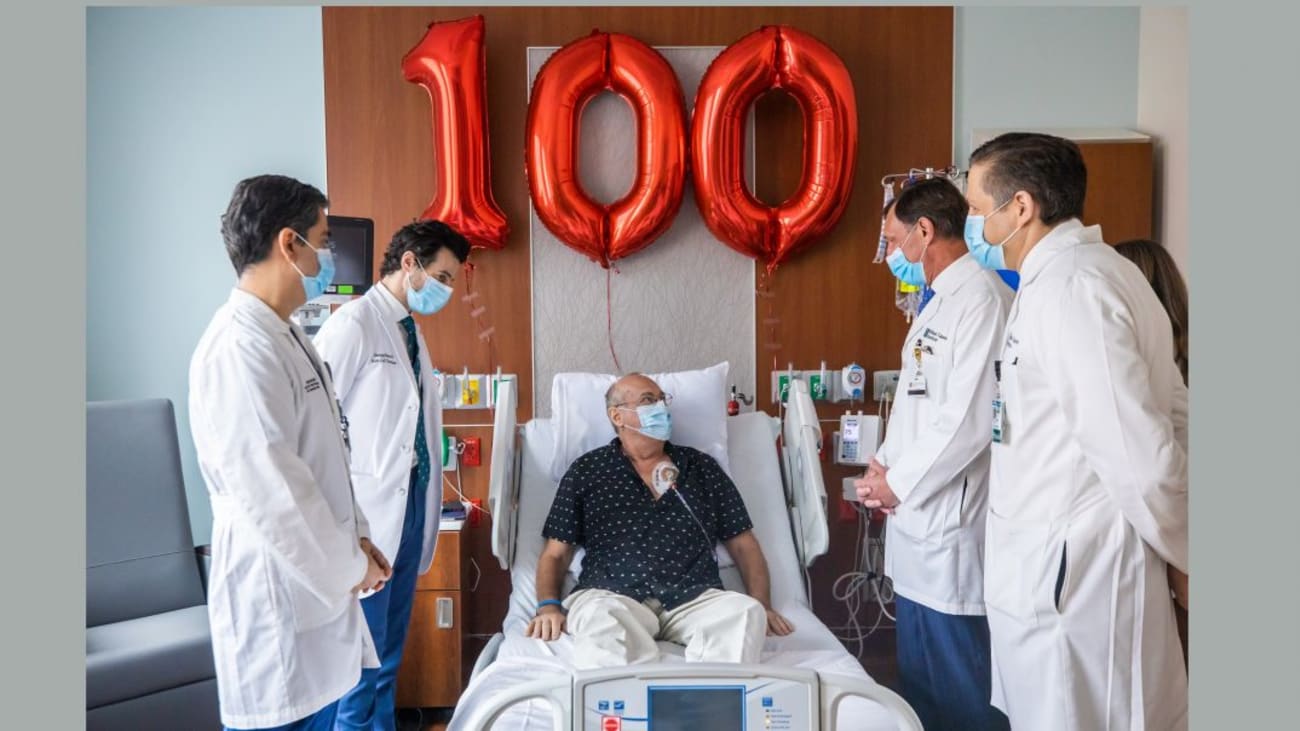

Miami Cancer Institute has marked the 100th patient of its Blood and Marrow Transplantation program, where patients are treated for various forms of leukemia, multiple myeloma and other blood cancers.
The stem cells are either collected from their own bone marrow (autologous stem cell transplant) or are derived from a stem cell donor (allogeneic stem cell transplant). In this case, the stem cells are first modified in the laboratory to reduce side effects following the transplantation before the final stem cell product is infused.
It is a remarkable milestone considering that the program was launched about 18 months ago, which covers the extremely challenging last 12 months amid the coronavirus pandemic, said Guenther Koehne, M.D., Ph.D., the Institute’s deputy director and chief of Blood and Marrow Transplantation, Hematologic Oncology and Benign Hematology.
(Watch now: Hear from patient Glenn Sattell, Guenther Koehne, M.D., Ph.D., the Institute’s deputy director and chief of Blood and Marrow Transplantation, and George Nahas, D.O, medical oncologist, as they discuss the 100th patient milestone. )
“I feel quite enthusiastic that we reached this milestone within this short time period at Miami Cancer Institute,” says Dr. Koehne. “It is quite an accomplishment.”
The program provides advanced treatment options to patients with blood cancers such as leukemia, multiple myeloma, non-Hodgkin lymphoma and Hodgkin disease and other hematologic malignancies. The 100th patient, Glenn Sattell, was diagnosed with multiple myeloma.
“Mr. Sattell had a diagnosis of multiple myeloma, which is a disease of plasma cells that are kind of growing out of control and produce an abnormal protein,” explains George Nahas, D.O, medical oncologist at Miami Cancer Institute, with a focus on hematologic malignancies and stem cell transplants.
‘Best Place to be for My Condition’
Hope Tower, which opened during the summer in a building adjacent to Miami Cancer Institute, is home to the Institute’s inpatient bone marrow and immunotherapy programs, and it’s dedicated to stem cell transplant patients, like the 100th patient that marked the recent milestone.

Patient Glenn Sattell
“When I got the diagnosis, it was obviously a shock,” recalls Mr. Sattell, the 100th patient. “I’ve been a pretty healthy person all my life. It was a lot to take in. I chose Miami Cancer Institute because I was convinced that it’s the best place to be for my condition, and it’s proven so far to be right. Doctors, nurses — everybody associated with (the Institute) — have been fantastic.”
The Institute’s Hematologic Oncology and the Blood &Marrow Transplantation program is developing so fast that three new physicians will join the program in July, said Dr. Koehne.
Goal: 100 to 150 Patients Per Year
“This milestone of 100 transplants — starting from the desire of developing a transplant program at MCI to patient No. 100 — is remarkable,” said Dr. Koehne. “It involved the recruitment of physicians, laboratory staff and the stem cell processing laboratory that needed to be built. And the new inpatient tower that we now have for transplant patients.”
Dr. Koehne predicts about “100 to 150 transplants per year from now on.”

Guenther Koehne, M.D., Ph.D., the Institute’s deputy director and chief of Blood and Marrow Transplantation, Hematologic Oncology and Benign Hematology.
The Institute’s Blood & Marrow program also conducts CAR T-cell therapies, or “chimeric antigen receptor T-cell therapy.” That’s when the patient’s T-cells, a type of white blood cell, are collected and genetically modified to express a new marker that targets and kills leukemia, lymphoma or multiple myeloma cells. Once the cells are modified, they are infused back into the patient to recognize and attack the abnormal cell population.
“Every transplant program has a laboratory,” said Dr. Koehne. “In our lab, we are performing what’s called graft manipulation, or cell processing. For that reason, it is well-equipped and staffed to allow us to do everything right, and in-house.”
Everything is in place for the Institute’s Blood and Marrow Transplantation Program to expand its services to patients, says Dr. Nahas. “I came here 19 months ago, so I saw the entire growth from 18 months ago until now — and it’s been phenomenal,” he says. “And we’ve had impressive results as well. I’m very proud to be a part of it.”